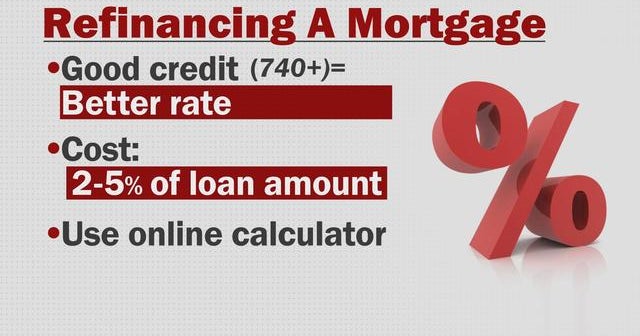Advice for homeowners looking to refinance their mortgage

Refinancing your mortgage can be a smart financial move for homeowners looking to save money on their monthly payments or pay off their loan faster. With interest rates at historic lows, now may be the perfect time to consider refinancing your mortgage.
According to CBS News, almost 63% of mortgage applicants are homeowners looking to refinance. Jill Schlesinger explains how low mortgage rates could help homeowners cut their costs, as part of the Eye on Money series. Refinancing your mortgage can potentially save you thousands of dollars over the life of your loan.
One of the main reasons homeowners choose to refinance is to take advantage of lower interest rates. By refinancing at a lower rate, you can reduce your monthly payments and save money over the long term. Additionally, refinancing can allow you to switch from an adjustable-rate mortgage to a fixed-rate mortgage, providing more stability and predictability in your monthly payments.
Another benefit of refinancing is the ability to tap into your home’s equity. By refinancing, you can access cash to make home improvements, pay off high-interest debt, or cover unexpected expenses. This can be a cost-effective way to borrow money compared to other types of loans.
Before refinancing your mortgage, it’s important to carefully consider your financial goals and the costs involved. Refinancing typically involves closing costs, which can add up to thousands of dollars. Make sure to calculate the break-even point to determine how long it will take to recoup these costs through your lower monthly payments.
It’s also essential to shop around and compare offers from multiple lenders to ensure you’re getting the best deal. Consider working with a mortgage broker who can help you navigate the refinancing process and find the most competitive rates. Additionally, be sure to check your credit score and make any necessary improvements to increase your chances of qualifying for the lowest rates.
In conclusion, refinancing your mortgage can be a smart financial move for homeowners looking to save money, access cash, or achieve other financial goals. With interest rates at historic lows, now may be the perfect time to consider refinancing your mortgage. By carefully weighing the costs and benefits and shopping around for the best rates, you can make an informed decision that aligns with your financial objectives. With mortgage rates hitting record lows, homeowners have a unique opportunity to cut their costs by refinancing their mortgages. Jill Schlesinger, a financial expert, explains how low mortgage rates can benefit homeowners in our Eye on Money series.
Schlesinger highlights that nearly 63% of mortgage applicants are homeowners looking to refinance their current mortgages. This trend is driven by the historically low mortgage rates that are currently available in the market. By refinancing at a lower rate, homeowners can potentially save money on their monthly mortgage payments and reduce the overall interest they pay over the life of the loan.
One of the key advantages of refinancing is the ability to lower your interest rate. With rates at historic lows, homeowners may be able to secure a lower rate than what they initially agreed to when they purchased their home. This can result in significant savings over time, especially for those with higher interest rates on their current mortgages.
In addition to lowering the interest rate, refinancing can also help homeowners switch from an adjustable-rate mortgage to a fixed-rate mortgage. This can provide stability and predictability in monthly payments, as fixed-rate mortgages have a constant interest rate for the life of the loan. This can be particularly beneficial in a fluctuating interest rate environment.
Schlesinger also emphasizes the importance of considering the costs associated with refinancing. While refinancing can lead to long-term savings, it’s important for homeowners to weigh the upfront costs of refinancing, such as closing costs and fees. It’s essential to calculate the breakeven point – the point at which the savings from refinancing outweigh the costs – to determine if refinancing is a financially sound decision.
Overall, low mortgage rates present a valuable opportunity for homeowners to reduce their housing costs through refinancing. By taking advantage of these rates and carefully evaluating the costs and benefits of refinancing, homeowners can potentially save money and achieve greater financial stability in the long run. The world of technology is constantly evolving and advancing, with new innovations and breakthroughs being made every day. One of the most exciting recent developments in the tech world is the rise of artificial intelligence (AI). AI is a branch of computer science that aims to create machines that can perform tasks that typically require human intelligence, such as speech recognition, decision-making, and problem-solving.
One of the key areas where AI is making a significant impact is in the field of healthcare. The use of AI in healthcare has the potential to revolutionize the way doctors diagnose and treat patients, leading to more accurate and personalized care. AI-powered algorithms can analyze vast amounts of medical data in a fraction of the time it would take a human doctor, leading to quicker and more accurate diagnoses. This can be especially beneficial in cases where time is of the essence, such as in emergency situations or when dealing with time-sensitive diseases like cancer.
AI can also be used to predict and prevent diseases before they occur. By analyzing a patient’s medical history, genetic information, and lifestyle factors, AI algorithms can identify individuals who are at high risk for certain conditions and recommend preventive measures. This proactive approach to healthcare can help reduce the burden on the healthcare system and improve overall public health.
In addition to diagnosis and prevention, AI is also being used to improve the efficiency of healthcare operations. AI-powered systems can streamline administrative tasks, such as scheduling appointments, processing insurance claims, and managing electronic health records. By automating these routine tasks, healthcare providers can focus more on patient care and spend less time on paperwork.
Despite the many benefits of AI in healthcare, there are also challenges and concerns that need to be addressed. One of the main concerns is the potential for bias in AI algorithms. If the data used to train AI models is biased or incomplete, the algorithms may produce inaccurate or discriminatory results. This can have serious consequences for patients, especially those from marginalized or underrepresented communities.
Another challenge is the need for regulations and ethical guidelines to govern the use of AI in healthcare. As AI technology continues to advance, it is important to ensure that it is used responsibly and ethically. This includes protecting patient privacy, ensuring data security, and preventing misuse of AI for profit or harm.
Overall, the future of AI in healthcare is promising, with the potential to improve patient outcomes, reduce healthcare costs, and revolutionize the way healthcare is delivered. By harnessing the power of AI, healthcare providers can provide more personalized and effective care to patients, leading to a healthier and happier population. As we enter a new year, many of us are filled with hope and excitement for what the future may hold. With the challenges of the past year behind us, we are looking forward to a fresh start and new opportunities. As we reflect on the lessons learned and the changes that have taken place, we are ready to embrace the possibilities that lie ahead.
One of the key themes that emerged from the past year was the importance of resilience and adaptability. The COVID-19 pandemic forced us to rethink the way we live and work, and many of us had to quickly adjust to new ways of doing things. From working remotely to finding new ways to stay connected with loved ones, we learned to be flexible and embrace change.
As we move forward into the new year, it is important to carry these lessons with us. The ability to adapt and pivot when faced with challenges will be crucial as we navigate the uncertainties that lie ahead. Whether it’s in our personal lives or in our careers, being able to think creatively and find solutions to problems will be key to our success.
Another important takeaway from the past year is the value of community and connection. The pandemic showed us just how important it is to support one another and come together in times of need. Whether it was checking in on neighbors, volunteering to help those in need, or simply reaching out to friends and family to offer support, we saw the power of coming together as a community.
As we look to the future, it will be important to continue to nurture these connections and strengthen our communities. Building strong relationships and fostering a sense of belonging can help us weather any storm and thrive in the face of adversity.
Finally, as we embark on this new year, it is important to remember the importance of self-care and well-being. The past year was incredibly challenging for many of us, and it is crucial that we take the time to prioritize our mental and physical health. Whether it’s through exercise, meditation, spending time in nature, or simply taking a break to relax and recharge, making time for self-care is essential for our overall well-being.
As we look ahead to the future, let us carry these lessons with us and approach the new year with optimism and determination. By embracing resilience, fostering connections, and prioritizing self-care, we can navigate whatever challenges come our way and create a brighter future for ourselves and those around us. The world of art and culture is a vast and diverse one, with countless genres, styles, and mediums to explore. From traditional paintings to avant-garde sculptures, there is something for everyone to appreciate and enjoy.
One genre of art that has been gaining popularity in recent years is digital art. Digital art encompasses a wide range of mediums, including digital painting, 3D modeling, and animation. Artists who work in this medium often use software such as Adobe Photoshop, Blender, and Maya to create their pieces, which can then be shared online or printed out for display.
One of the advantages of digital art is its versatility. Artists can easily experiment with different styles and techniques, without the need for expensive materials or equipment. This has led to a flourishing online community of digital artists, who share their work on platforms such as Instagram, DeviantArt, and ArtStation.
Another benefit of digital art is its accessibility. Unlike traditional art forms, which may require years of training and practice to master, digital art can be picked up relatively quickly by anyone with a computer and a creative spark. This has opened up the art world to a whole new generation of artists, who may not have had the opportunity to explore their talents otherwise.
Digital art also allows for greater collaboration and interaction between artists. Through online forums and social media, artists can share their work, offer feedback, and even collaborate on projects together. This sense of community and camaraderie is invaluable to many digital artists, who may otherwise feel isolated in their creative pursuits.
Of course, like any art form, digital art has its challenges and limitations. Some may argue that digital art lacks the tactile quality of traditional mediums, such as paint on canvas or clay in hand. Others may question the longevity and value of digital artworks, which can be easily replicated and distributed online.
Despite these concerns, digital art continues to push boundaries and inspire artists around the world. Its limitless possibilities and innovative techniques make it an exciting and dynamic field to explore. Whether you’re a seasoned artist or a curious beginner, digital art offers a unique opportunity to create, collaborate, and connect with others in the ever-evolving world of art and culture.





